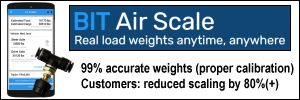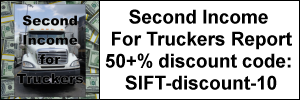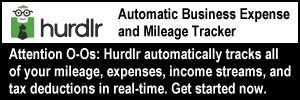This glossary of trucking terms — aka trucker lingo or trucking terminology — is provided as a courtesy to help you professional truck drivers save money in the transportation industry.
These have been compiled primarily for use by truckers in the USA. Other terms may be used in other countries.
These are our own definitions. If you think that any definition needs to be clarified, corrected or updated, please contact us. We plan to expand the list over time.
Glossary of Trucking Terms starting with Numbers
- 18 wheeler: A nickname for a semi-tractor trailer, pertaining to those trucks that have a 10-wheel tractor (steering axle with two tires and two drive axles with four tires each) and an 8-wheel trailer (two axles with four tires each).In order to drive an 18-wheeler, a driver must possess a Class A Commercial Driver’s License. (Note: not all large trucks have 18 wheels; some have more and some have less.)
- 34-hour restart: Regarding professional drivers’ hours of service (HOS), as defined by the Federal Motor Carrier Safety Administration, is any period of 34 consecutive hours off-duty that “restarts” the 60/70 hour calculation.(1)(2)
- 3PL: Courtesy of this article, “A third-party logistics company (3PL) is a service provider that either arranges or handles a variety of supply chain functions for a business. … These functions can include brokering, shipping, storing, or packing a company’s freight, as well as supply chain strategy and access to technology.”
Glossary of Trucking Terms starting with Letters A-B
- ADAS: advanced driver assistance systems (courtesy of this article).
- ADS: automated driving systems.
- ADL: alternative delivery locations;
- AEB: automatic emergency braking (courtesy of this article);
- AI: Artificial Intelligence.
- AMRs: autonomous mobile robots (courtesy of this article);
- articulated: When applied to a large truck, is each segment (tractor and each trailer) connected by a pivoting joint (king pin fitting into a fifth wheel platform).
- autonomous vehicle: a vehicle that is either partially or fully driven without human interaction; AKA driverless and/or self-driving.
- AV: Autonomous vehicle;
- backing: The activity being performed when a driver has his or her truck in reverse gear. Among the most often used forms are straight line backing, 90-degree alley docking, and offset alley docking. See our article on how to back up your truck safely.
- BEV: “Battery Electric Vehicle” or “Battery-Powered Electric Vehicle.”
- big rig: A nickname for a semi-tractor trailer, consisting of the tractor and trailer.
- BOPIS: Buy-online, pick-up-in-store.
- BOPA: Buy-online, pick-up-anywhere.
- Brake check: According to this resource: “A brake check, also known as a brake test, occurs when a driver deliberately either taps on the brakes several times or slams hard on the pedal when moving in front of another vehicle, with the intention of causing the behind driver to either collide or take evasive action.”
Glossary of Trucking Terms starting with Letter C
- CARB: California Air Resources Board
- CAYG: Clean As You Go.
- CDL: Abbreviation for Commercial Driver’s License.
- CMV: Abbreviation for Commercial Motor Vehicle.
- CNG: Compressed Natural Gas.
- Cold chain: “The cold chain is the management of temperature for perishable products in order to maintain quality and safety from the point of origin through the distribution chain to the final consumer.” (source)
- Comdata Card: Also known as a “ComCard,” a plastic card with an embedded magnetic strip, issued by Comdata Services, which is connected to a credit account, most often used by some professional drivers to buy fuel, but also used to purchase other goods and services.
- Comdata Check: Also known as a “ComCheck,” a piece of paper issued by Comdata Services, which is connected to a credit account and requires additional authorization (such as a purchase order number), most often used by some professional drivers to buy lumper services, but also used to purchase other goods and services.
- Comdata Services: According to its website, http://www.comdata.com/, “For four decades, Comdata has been at the forefront of payment innovations. We invented the concept of electronic payments for transportation, and in the process launched the Comdata Card – a payment solution that helped drive an industry.”
- CPG stands for Consumer Packaged Goods.
- CSA 2010: According to its website, http://csa2010.fmcsa.dot.gov/about/, “Compliance, Safety, Accountability (CSA) … is FMCSA’s data-driven safety compliance and enforcement program designed to improve safety and prevent commercial motor vehicle (CMV) crashes, injuries, and fatalities. CSA consists of three core components; the Safety Measurement System (SMS); interventions; and a Safety Fitness Determination (SFD) rating system to determine the safety fitness of motor carriers.”
Glossary of Trucking Terms starting with Letters D-H
- DataQs: “an FMCSA system that allows carriers and drivers to request and track a review of crash or inspection data that the requester believes is incomplete or incorrect.” (courtesy of LandLine.media)
- DOT: U.S. Department of Transportation.
- drop and hook: Being able to drop a loaded trailer at the consignee, hook to an empty trailer and not have to wait on your trailer to be unloaded live before leaving.
- double blind delivery: a delivery in which the shipper wants to hide their details in the shipment — and neither the shipper nor the receiver sees each other’s Bills of Lading.
(courtesy of https://www.truckingoffice.com/blog/what-is-a-double-blind-delivery/) - double drop and hook: The series of moves a driver undertakes when he
- drops trailer #1,
- hooks to trailer #2 (which is almost always in a space or dock where trailer #1 needs to go),
- moves trailer #2 and drops it,
- rehooks to trailer #1,
- moves trailer #1 to the desired space and drops it,
- rehooks to trailer #2.
(Even though this series of moves actually involves three drops and three hooks, it involves only two trailers.)
- doubles: two short trailers connected back to front by a converter gear and pulled in series behind a tractor. Because of the height to length ratio, they are more likely to overturn than a standard long van, high cube doubles even more so.
- double forty-eights: instead of two short trailers being pulled by a tractor, this is two 48-foot trailers being pulled by a tractor. Because of the length of this kind of rig, some drivers refer to double-48s as “freight trains.” The number of places where this length of vehicle is permitted to operate is small, usually on turnpikes with parking areas near toll plazas where drivers can connect or disconnect the trailers.
- DVIR: Driver Vehicle Inspection Report. (For more information, please see this article.)
- eBOL: Electronic Bill of Lading, courtesy of this article.
- ERG: Emergency Response Guidebook.
- EV: Electric vehicle;
- FBX: Freightos Baltic Index, “the world’s leading — and most accurate — index of market rates for 40′ containers” (according to this article).
- FCEV: According to this article, the first three letters stand for “fuel-cell-electric” and we assume the “V” stands for “vehicle”;
- F.E.T. (or FET): Federal Excise Tax
- Federal Highway Administration (FHWA): According to its website, http://www.fhwa.dot.gov/, “FHWA is charged with the broad responsibility of ensuring that America’s roads and highways continue to be the safest and most technologically up-to-date” and its mission is to “Improve Mobility on our Nation’s Highways Through National Leadership, Innovation and Program Delivery.”
- Federal Motor Carrier Safety Administration (FMCSA): According to its website, http://www.fmcsa.dot.gov/, “The Federal Motor Carrier Safety Administration (FMCSA) was established as a separate administration within the U.S. Department of Transportation on January 1, 2000, pursuant to the Motor Carrier Safety Improvement Act of 1999” and “Our primary mission is to reduce crashes, injuries, and fatalities involving large trucks and buses.”
- FLSA: Fair Labor Standards Act.
- GHC: Global Household Goods Contract (courtesy of this resource).
- G.O.A.L.: Get Out And Look.
- GRI: General Rate Increase, courtesy of this resource. The article states, “Most carriers issue annual GRIs on general tariffs near the end or at the beginning of a year. General rate increases are used to adjust base rates to counter cost inflation and fund capital investments. While the percentage of the increase will vary by lane, distance and weight class…”.
- “high cube”: A short van which is usually pulled as part of “doubles” or “triples” but which is 14’3″ tall instead of the standard 13’6″ tall. Because of its extra height, it is intended to be run only in western U.S. states where the height restriction is higher than on the East Coast. A driver who drives high cubes in states where the height restriction is 13’6″ risks receiving a fine and being put out of service.
- HHG: Household Goods
Glossary of Trucking Terms starting with Letters I-J
- ICE : “Internal Combustion Engine.”
- IFTA: According to The Free Dictionary on this subject, “The International Fuel Tax Agreement (or IFTA) is an agreement between the lower 48 states of the United States and the Canadian provinces, to simplify the reporting of fuel use by motor carriers that operate in more than one jurisdiction. An operating carrier with IFTA receives an IFTA license, a set of decals which are applied to qualifying vehicles, and a quarterly fuel tax report. This report shows the net tax or refund due.”
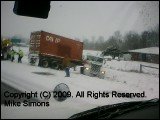
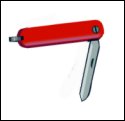 jackknife: The acute angle (less than 90 degrees) of a tractor in position to the semi-trailer to which it is attached, most often seen in accidents in which a professional driver has lost control of his or her articulated vehicle. During accidents resulting in jackknifed rigs, the momentum of the trailer has forced the tractor to spin around facing backwards. See the similarities between a jackknifed rig and the blade of a folding pocket knife in an acute angle with respect to its body in these images:
jackknife: The acute angle (less than 90 degrees) of a tractor in position to the semi-trailer to which it is attached, most often seen in accidents in which a professional driver has lost control of his or her articulated vehicle. During accidents resulting in jackknifed rigs, the momentum of the trailer has forced the tractor to spin around facing backwards. See the similarities between a jackknifed rig and the blade of a folding pocket knife in an acute angle with respect to its body in these images:
Glossary of Trucking Terms starting with Letters K-M
- inverter: A device used to invert DC (direct current) power into AC (alternating current) power. See our article on inverters.
- last mile: According to this article: “The final mile delivery, also known as last mile delivery, is the last step of the product’s journey. It is the point at which the good is finally delivered to the end customer—i.e. the consignee. The final mile is key to achieving high customer satisfaction but is often the most time-consuming and costly stage of the entire shipping process.”
- live load: The loading of freight onto a semi-trailer which the driver is waiting to move.
- live unload: The unloading of freight from a semi-trailer which the driver is waiting to move.
- LNG: Liquefied Natural Gas.
- LTL: less-than-truckload.
- MCS-150: “The MCS-150, or Motor Carrier Identification Report, is a form filed to obtain and update your USDOT number” and “Any motor carrier with a DOT Number is required to file a biennial MCS-150 update. You should also file an update any time something about your business changes, for instance, if you have a new company name or add trucks to your fleet.” (courtesy of this resource)
- MELT: Mandatory Entry-Level Training (courtesy of this resource).
Glossary of Trucking Terms starting with Letters N-P
- National Highway Traffic Safety Administration (NHTSA): According to its website, http://www.nhtsa.dot.gov/, this government agency’s mission is to: “Save lives, prevent injuries and reduce economic costs due to road traffic crashes, through education, research, safety standards and enforcement activity.”
- National Motor Freight Traffic Association (NMFTA): According to its website, http://www.nmfta.org/, “NMFTA publishes the National Motor Freight Classification (NMFC), which is a standard that provides a comparison of commodities moving in commerce.”
- Nearshoring (courtesy of InTek Freight and Logistics, Inc.): “Nearshoring is where a business moves its operations to a nearby country from one of greater distance.”
- NIMBY: Not In My Back Yard.
- NRW: Acronym for “not road worthy.” This means that the vehicle or trailer is not in good enough shape to be taken out on the open road. A trailer so designated may, in some cases, still be used for storage.
- NTI: According to this search result, “The FreightWaves SONAR National Truckload Index (NTI) is a seven-day moving average of freight spot rates that measures the U.S. for-hire, over-the-road dry van trucking market”.
- OMFIP: Office of Multimodal Freight Infrastructure and Policy (Multimodal Freight Office).
- Nuclear Verdict: According to this article: “The term “Nuclear Verdict” is defined as a verdict over $10 million.”
- “per diem”: According to this article: “the term ‘per diem’ is from Latin, and it translates to ‘for each day.’ This is the reimbursement for your daily expenses (while on the job) as a trucker.” (Please see the rest of the article for details.) This web page lists the per diem details for a particular calendar year.
- Professional Truck Driver Institute (PTDI): According its website, http://www.ptdi.org/, “PTDI is the first nonprofit organization to develop uniform skill performance, curriculum, and certification standards for the trucking industry and to award course certification to entry-level truck driver training courses and motor carrier driver-finishing programs.”
Glossary of Trucking Terms starting with Letters Q-Z
- regional: Short regional: 50 miles from depot; Medium regional: 100 miles from depot; and Long regional: 100 to 300 miles from depot with return-to-base (courtesy of NACFE, from this article).
- RNG: Renewable Natural Gas
- tandems: A pair of axles, usually denoting trailer axles that can be moved by sliding them forward or backward along a track built on the underside of the trailer.
- TCA: Truckload Carriers Association.
- THC: tetrahydrocannabinol, which is the “main psychoactive property in marijuana.”
- Trailerism: According to this article: “The erroneous belief that one type of work involving a specific type of semi-trailer is superior to another and that anyone who does an inferior type of work is less of a person for doing so.”
- transloading (courtesy of Investopedia): “a shipping term that refers to the transfer of goods from one mode of transportation to another en route to their ultimate destination.”
- triples: like “doubles” except three short vans connected in series with two converter gears between them.
- UCR stands for “Unified Carrier Registration”.
- U.S. Department of Transportation (DOT): According to its website, Transportation.gov “The Department of Transportation was established by an act of Congress on October 15, 1966. The Department’s first official day of operation was April 1, 1967.” and this government department’s mission is to: “Serve the United States by ensuring a fast, safe, efficient, accessible and convenient transportation system that meets our vital national interests and enhances the quality of life of the American people, today and into the future.”
- Vehicle boot: According to this article: “Vehicle booting has long been a tool of last resort in the collection of unpaid parking citations. A traditional boot is a large, heavy metal device that clamps onto one of the wheels of a vehicle with the intent of preventing the vehicle from driving away.”
- VMRS: Vehicle Maintenance Reporting Standards (courtesy of TruckingInfo.com).
- VMT: Vehicle Miles Traveled (a taxing mechanism).
- Wheel-Off: When a wheel comes off a tractor or trailer, possibly with more hardware.
- WIA: Workforce Investment Act.
- Wide-Base Tire: The same thing as a “super single.”
- “Windshield barnacle”: According to this April 8, 2024, article, “New York City police have escalated their attack on illegally parked trucks by slapping 17-pound windshield boots known as barnacles on some trucks. … The barnacles use powerful suction cups to attach to a truck’s windshield obscuring the driver’s view, rendering the truck undrivable.”
- ZEV: Zero-Emission Vehicle (courtesy of TruckNews.com).
See more: “Trucker Lingo.”
See more: “Truck Slang And CB Lingo You Need To Know”
Return from A Glossary of Trucking Terms to Help Truckers Save Money to our Trucking Driving Jobs page or our Truck Drivers Money Saving Tips home page.
References:
1. www.fmcsa.dot.gov/rules-regulations/truck/driver/hos/brochure.htm (no longer online)
2. www.fmcsa.dot.gov/rules-regulations/truck/driver/hos/hos-faqs.asp#_Toc111021256 (no longer online)

